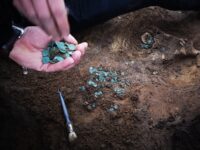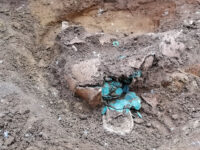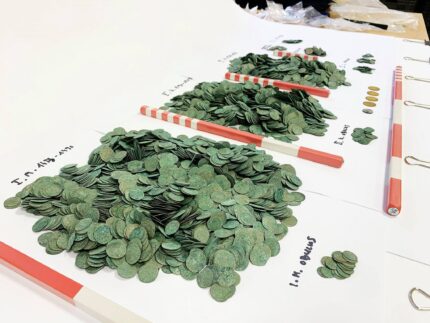 A hoard of almost 7,000 coins, most of the medieval, has been unearthed in the village of Újlengyel, 30 miles southeast of Budapest, Hungary. This is the largest hoard of coins from the period ever discovered in Pest county.
A hoard of almost 7,000 coins, most of the medieval, has been unearthed in the village of Újlengyel, 30 miles southeast of Budapest, Hungary. This is the largest hoard of coins from the period ever discovered in Pest county.
The site first came to the attention of the Ferenczy Museum Center in 2019 when 150 coins, the most recent dating to 1455, were discovered. At the end of December 2020, a team of archaeologists and volunteers from the Community Archaeological Association explored the site with metal detectors and hit the big jackpot on a hill a little ways away from the original find spot.
 Based on the grouping of the coins close to the surface, archaeologists dug a pit three feet square. Within its confines, the team unearthed a pottery vessel in which the coins had been stashed. Its round belly had been broken by ploughing activity and the coins disturbed. Unusual in these kinds of finds, the marks of the plough in the pot and the ground were still clearly visible, so archaeologists were able to follow the movements of the displaced coins.
Based on the grouping of the coins close to the surface, archaeologists dug a pit three feet square. Within its confines, the team unearthed a pottery vessel in which the coins had been stashed. Its round belly had been broken by ploughing activity and the coins disturbed. Unusual in these kinds of finds, the marks of the plough in the pot and the ground were still clearly visible, so archaeologists were able to follow the movements of the displaced coins.
The pot was too broken to keep together in one piece, so the coins and pot fragments were removed and brought to the museum for cleaning and examination. Ferenczy Museum Center experts counted almost 7,000 silver coins and four gold coins in the hoard. The oldest was a silver denarius of Lucius Verus (161–169 A.D.). There were also a dozen late Imperial silver denarii struck in Aquileia mint. The coins then leap to the 15th century, with issues struck by Matthias I of Hungary (r. 1458–1490), Vladislaus II (1490–1516) and Louis II (1516-1526). One notable piece is Vatican coin struck during the papacy of Pius II (1458-1464). These are extremely rare finds in Hungary. The four gold coins date to the reign of Matthias I. They were a surprise discovery, found by museum conservators hidden behind a textile that lined the belly of the vessel.
The total value of the coins was enough to buy seven horses in Pest in 1520, enough buying power to buy a luxury car today. The newest coin in the hoard dates to 1520, so it’s likely the hoard was buried around the time of the Ottoman wars (1526) which claimed the life of King Louis II. In the wake of his death, Hungarian nobles fought over the succession and instability reigned. In this troubled environment, stashing your money in a jar and burying it was a judicious savings plan.
